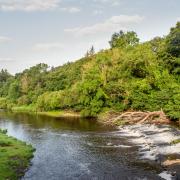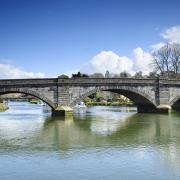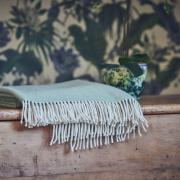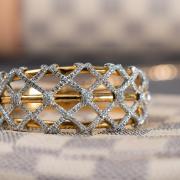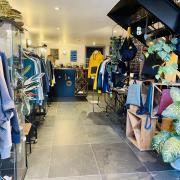Local writer, author and ‘campervan cook’ MARTIN DOREY doesn’t worry if his pinkies get tickled in the shallows by a few fronds of seaweed. In fact, once he’s bathed in it, he might well make a meal of it too. Join him on a beach walk to find out why…

Eating seaweed straight off the beach always tends to get an interesting reaction. People, as I have found, are more than a little squeamish about it. To the uninitiated, seaweed is inedible, slimy, dirty, smelly and full of underwater creepy crawlies that nip and sting when you suffer the misfortune of wading or swimming through it. Mind you, eating seaweed does begin to look like the saner option when I begin to talk about the virtues of bathing in it and how brilliant it can be for the skin and hair.
“You put seaweed in your hair? That’s wrong.”
That’s the point at which I usually lose my audience and they drift off to wave their nets aimlessly in rock pools, leaving me waving a frond of fuccus serratus as they go.
“That’s one less guest for dinner,” I think to myself, “and more room in the old tin tub for me.”

People don’t like seaweed.
But they blooming well should. Seaweed is wonderful stuff with amazing properties and its own range of unique tastes. It’s used all over the world for all kinds of things, from setting blancmange to making beauty products. But here in the UK we largely ignore it, unless of course you count deep fried crispy seaweed from a Chinese restaurant. And that’s not real seaweed.
Thankfully, in North Devon, you can still buy one type of seaweed from a few select retailers. It’s called purple laver and it’s been eaten in Appledore and Northam forever. Until it closed, the Cross Street Chippie in Northam used to serve it deep fried in batter. There are still a few locals who like to gather and cook it (it needs at least four hours cooking time) and then use it to make sausages, laver bread or to spread on their toast. Trust me, laver rolled in oats and cooked in bacon fat is a breakfast treat no one should miss out on. It’s full of iron and vitamins and tastes wonderful.
Of course many of us eat purple laver, albeit without knowing, as it is also known as ‘nori’ in Japanese cooking. And in case you didn’t know what that is, let me inform you that it is a vital part of any meal of sushi because it’s the black film that encases sushi rolls and wraps. Eeeew? No, not really. Head to F. Heards the butcher in Westward Ho! and try their pork and laver sausages. If you are curious about seaweed, it’s an easy start. Of course, they are absolutely delicious.
But let’s get back to the seaweed bath. I first discovered these on a trip to Ireland many years ago. There are still a number of traditional bath houses operating around the west coast, particularly in Sligo and Donegal. The story goes that farmers who had been handling seaweed to spread on their fields noticed that their skin stayed healthier and didn’t dry out and crack when they were working with it.
Eventually some Edwardian bright spark put two and two together and invented the seaweed spa, with steam bath, hot and cold showers and a few snails and shrimps thrown in for good measure. It’s a wonderful way to spend an hour and you will come out feeling great. The seaweed has a rich and silky feel and leaves skin feeling refreshed, moisturised and almost zinging with life. You don’t even have to go to Ireland to enjoy it. Run a hot bath, add a handful of sea salt and chuck in a bucket of freshly picked serrated wrack. Then rub it all over.
Too much? Try it. Seaweed will always surprise you.
Ten ways to enjoy seaweed
Squeamish? Don’t be. Seaweed is a fast growing, underrated resource.
1.Carrageen contains natural agar (a thickener) and can be used to make divine panna cotta (a posh word for blancmange) if you extract the agar and then mix with milk, sugar, cream and some vanilla seeds. The agar thickens the milk until it sets and gives it a lovely light texture.
2.Carrageen can also be used to make a Caribbean rum cocktail called sea moss. It’s flavoured with cinnamon and nutmeg and is drunk warm.
3.Sugar kelp makes great seaweed crisps. Just dry it out (in a very low oven) until it’s crispy and away you go. It’s sweet and crisp and salty – a definite taste of the shore.
4.Sea spaghetti is a fantastic vegetable and takes marinating well. Try it with chilli, lemon juice and garlic.
5.Sea lettuce is one of the few seaweeds that can be eaten raw. Look for the thin green wispy sheets that you’ll find towards the high tide mark on your local beach.
6.Dulse, or duilasc, as it’s known in Ireland, is crunchy and nutty and was used generations ago as a snack.
7.Gut weed or sea grass, which grows towards the high tide mark and in brackish water, is useful for frying into fritters. Just make sure it’s washed thoroughly.
8.Serrated wrack is the wrack that’s used in seaweed baths. Place in hot salted water and dive in. Check for snails and shrimps before you get in.
9.Purple laver boiled up for four hours and then rolled in oats before being fried in bacon fat, is divine. Try it with poached eggs, black pudding and sea beet for a proper Devon breakfast.
10.Sea grass can be used as a cap to steam limpets over a beach fire, if you dare. I dare you.
Understanding the intertidal zone
This is the area between the tides. It is usually divided naturally into three distinct zones. Even if you don’t intend to pick seaweeds it’s useful to know.
The Green zone is nearest the high tide mark. It is where you are likely to find green seaweeds like gut weed and sea lettuce. The red zone is the middle part of the foreshore where, on the whole, the red coloured seaweeds grow. This includes dulse. The brown zone is the lowest part that can only be accessed during spring tides. This is where you will find the kelps.
Think before you pick
•Seaweeds cling on to the rocks with clasps. If you pull seaweed it will come away from the rock and will eventually, the whole plant will die. So, when harvesting, use a knife to cut the top part of the plant away, leaving at least a third attached to the rock.
•Also, don’t pick where the water is dirty or there is a risk of pollution.
•Rinse all seaweeds well before using.
•Identify seaweeds before you pick. Whilst none are poisonous, only pick those you intend to use.
•Get permission from the beach owner.
•Don’t eat seaweed that’s been detached from the rocks already.
Go on a course, of course!!!
Fraser Christian at the Coastal Survival School runs interesting coastal foraging courses in South Devon/Dorset where you can learn all about eating the beach. I went. Loved it! coastalsurvival.com/ 07702 104644.




